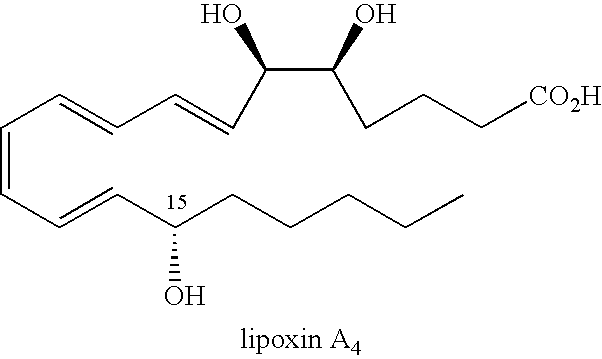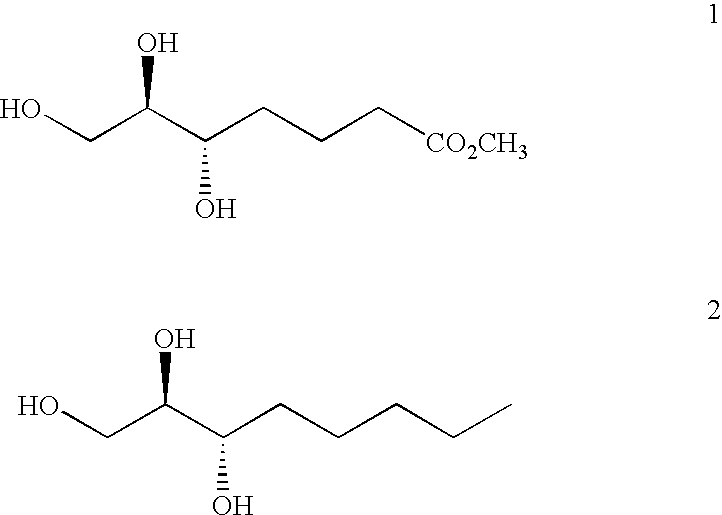Method of treating ocular allergy
a technology for ocular allergies and ocular skin, applied in the field of ocular skin allergy treatment, can solve the problems lid and conjunctival edema/redness, itching, tearing, etc., and achieves no highly effective and safe treatment regimen. , the effect of reducing the risk of ocular skin allergy
- Summary
- Abstract
- Description
- Claims
- Application Information
AI Technical Summary
Benefits of technology
Problems solved by technology
Method used
Image
Examples
example 1
Synthesis of Compound 3
[0034]
[0035]A solution of methyl ester 1 (20 mg, 0.104 mmol) in MeOH (2.1 mL) containing 1 M LiOH (0.5 mL, 0.5 mmol) was heated in a microwave heater at 120° C. for 6 minutes. The reaction was concentrated and the residue was chromatographed on a 10 mm diameter×18 cm tall C18 reverse-phase silica gel column eluting with 7:3 v:v 0.05 M HCl:acetonitrile to afford a crude white solid after concentration (40.9 mg). The solid was rinsed with hot CH3CN (2×2 mL) and the filtrate was concentrated to afford lactone 3 (7.8 mg, 47%). 13C NMR (150 MHz, dmso-d6) δ 171.12 (C), 79.86 (CH), 72.44 (CH), 62.03 (CH2), 29.39 (CH2), 21.67 (CH2), 17.55 (CH2).
example 2
Synthesis of Compound 4
[0036]
[0037]A solution of methyl ester 1 in aqueous MeOH is heated to reflux in the presence of 3 equivalents of lithium hydroxide. After 6 h the reaction is cooled to room temperature and the pH of the solution is adjusted to 6 by the addition of 70-9 mesh sulfonic acid resin MP (commercially available from Novabiochem / EMD Biosciences, 10394 Pacific Center Court, San Diego, Calif. 92121). The solution is filtered through a 0.2 μM poly-terfluoroethylene syringe filter and concentrated to afford the lithium carboxylate 4 as a white solid. 1H NMR (D2O, 400 MHz) δ 3.69-3.64 (m, 1H), 3.55-3.47 (m, 3H), 2.16-2.12 (m, 2H), 1.67-1.64 (m, 1H), 1.54-1.48 (m, 2H), 1.38-1.34 (m, 1H). 13C NMR (D2O, 100 MHz) δ 183.46 (C), 74.61 (CH), 71.67 (CH), 62.49 (CH2), 37.26 (CH2), 31.55 (CH2), 22.04 (CH2).
example 3
Synthesis of Compound 8
[0038]
[0039]2-deoxy-D-ribose is converted to the acetonide-protected lactol 10 by treatment with 2-methoxypropene and catalytic pyridinium p-toluenesulfonate (PPTS) in ethyl acetate. Wittig reaction with Ph3P═CHCO2Et in THF in the presence of catalytic benzoic acid affords enoate 11, which is reduced to 12 under a hydrogen atmosphere in the presence of catalytic Pd / C in ethanol. Deprotection of 12 using 0.1 N HCl in ethanol for 5 minutes, followed by quenching with aqueous NaHCO3, affords 8 after silica gel chromatographic purification.
PUM
| Property | Measurement | Unit |
|---|---|---|
| diameter×18 | aaaaa | aaaaa |
| pH | aaaaa | aaaaa |
| viscosity | aaaaa | aaaaa |
Abstract
Description
Claims
Application Information
 Login to View More
Login to View More - R&D
- Intellectual Property
- Life Sciences
- Materials
- Tech Scout
- Unparalleled Data Quality
- Higher Quality Content
- 60% Fewer Hallucinations
Browse by: Latest US Patents, China's latest patents, Technical Efficacy Thesaurus, Application Domain, Technology Topic, Popular Technical Reports.
© 2025 PatSnap. All rights reserved.Legal|Privacy policy|Modern Slavery Act Transparency Statement|Sitemap|About US| Contact US: help@patsnap.com



